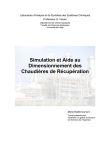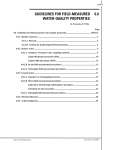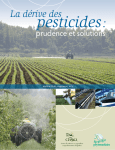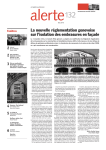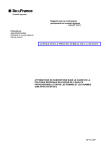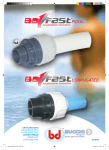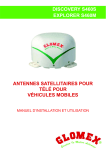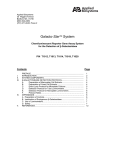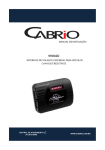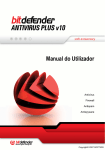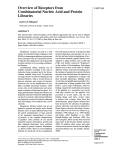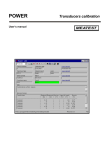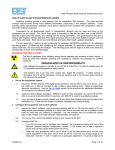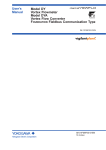Download SUMMARY AND CONCLUSIONS
Transcript
CHAPTER 7 SUMMARY AND CONCLUSIONS This research presents several new geostatistical methods for modeling subsurface site conditions and a geostatistical ground water modeling and visualization software package. The overall goals of developing these methods and tools are to better define site uncertainty, reduce site uncertainty, or simplify the process of modeling site uncertainty. These methods assist hydrogeologists in defining uncertainty in the ground water flow and contaminant transport modeling process, so that risks can be more accurately accessed and appropriate remediation methods can be better designed. Many of these methods and tools are also applicable to other scientific disciplines. 7.1: Summary and Conclusions Jackknifing the semivariogram, with small data sets (10’s to 100’s of samples), can be useful in describing the uncertainty associated with the definition of the model semivariogram. It can be combined with Latin-Hypercube Sampling and conditional indicator simulation to model overall site uncertainty, but its most useful feature may be facilitating quantitative evaluation of when enough data has been collected at the site to sufficiently describe the site spatial variation. Directional semivariograms more accurately model the spatial variation of the sample data. Instead of defining a single semivariogram model for the principle axis of site variability, and forcing the orthogonal axes of variation to use the same model adjusted with anisotropy factors, each orthogonal axis may be described and modeled independently. This simplifies the modeling process for the modeler, because it is not necessary to compromise by selecting one model that acceptably depicts all orientations. This advantage is partially offset, by the overall computational effort in the kriging process, because overall processing time approximately doubles. This is a reasonable tradeoff, because 1) modeler time is usually more valuable than computer time, and 2) most importantly, results are more accurate. Class conditional indicator simulation, versus threshold conditional indicator simulation, doesn’t appear to reduce model uncertainty nor improve model results, yet, it is a, valuable tool, because; 1) T-4595: Colorado School of Mines 163 SUMMARY AND CONCLUSIONS Wingle it is a more intuitive approach to defining and modeling indicator semivariograms; 2) it facilitates testing of model sensitivity to indicator ordering; and 3) it can be argued that, although the technique generates more order relation violations, these may more accurately represent the true number of problem matrices in the solution. In some situations, the threshold method fails to identify problems associated with the matrix solution. Zonal kriging addresses a common limitation of the geostatistical method at many sites. The sample data at many sites, do not honor the assumption of second-order stationarity, that is, the spatial variation of the data, as described by the experimental semivariogram, varies across the site. The zonal kriging method developed in this research automates some of the methods previously performed manually to address this situation, and adds several new tools to cope with transitions between zones. Again, by allowing the modeler to more accurately describe site conditions, this technique generates more accurate site estimates. The UNCERT software package incorporates all the methods described above in addition to other statistical and geostatistical methods, ground water flow and contaminant transport models, and visualization tools. This package simplifies the data handling, and the use of complex tools, thus aiding hydrogeologists in site evaluation and remediation design. It is also useful to scientists from other scientific disciplines. 7.2: Recommendations for Future Work There are several aspects of this research that could be further developed. Some relate to how the methods were tested and evaluated, while others relate to limitations of the methods themselves. First, the methods developed here are tested and evaluated under the premise that if uncertainty is reduced, ground water flow and contaminant transport model results will be more accurately match site conditions. This is a reasonable supposition, but it may not be true. Intuitively, a model with less uncertainty better describes true site conditions. The model results from these techniques should be tested using flow and transport models at controlled sites, to test this premise. The questions to ask are: 1) do these methods produce more consistent and more accurate results, 2) do they help reduce uncertainty in defining contaminant migration pathways, and 3) when inverse parameter estimation methods are implemented, are the sensitivities for the estimated parameters reduced? Two other issues that should be further researched relate specifically to the class and threshold conditional simulation methods. It is argued that, although the results between the methods are not identical, the methods produce substantially the same results. This conclusion is based on two observations. One is that the differences between the methods are approximately equivalent to the differences using the same method, with a different indicator ordering. Because ordering is arbitrary, theoretically it should not affect model results, however, there were small, local, differences for the limited number of simulations calculated (50 to 200). It would be useful to test and confirm that the differences due to indicator ordering, or class vs. threshold techniques, become smaller as the number of simulations is increased, possibly to 1000 or more. This was beyond the 164 T-4595: Colorado School of Mines 7.2: Recommendations for Future Work scope of this research due to limited computing facilities. The second observation related to the model differences, involves the significant differences in methods for resolving the order relation violations in the class and threshold simulations. Some of these differences can probably be eliminated, but they cannot be completely eliminated due to the nature of the two approaches. Finally the procedure for handling gradational and fuzzy transitions between zones is simplistic, but functional. When a cell is estimated, points from neighboring zones may be used in the kriging calculation. The equation used to described the spatial variance between the sample point and the cell being estimated, is the semivariogram model for the zone in which the cell is located. This disregards 1) the relative amount of separation distance in each zone, and 2) the possibility that a sharp bounding zone separates the point and the cell. These conditions were ignored for computational efficiency, but most importantly, due to concerns that the kriging matrix could no longer be guaranteed to be positive definite. This last issue however was not explored, but could be investigated in future work. T-4595: Colorado School of Mines 165 SUMMARY AND CONCLUSIONS 166 T-4595: Colorado School of Mines Wingle CHAPTER 8 BIBLIOGRAPHY Ababou, R., A.C. Bagtzoglou and E.F. Wood, 1994, “On the Condition Number of Covariance matrices in Kriging, Estimation, and Simulation of Random Fields.” Mathematical Geology, Vol. 26, No. 1, pp. 99-133. Alabert, F.G., 1987, Stochastic Imaging and Spatial Distributions Using Hard and Soft Information. Master’s Thesis, Department of Applied Earth Sciences. Stanford, Stanford University. Burden, R.L. and J.D. Faires, 1985, Numerical Analysis. Boston, Prindle, Weber, and Schmidt. Carle, S.F. and G.E. Fogg, 1996, “Transition Probability-Based Indicator Geostatistics.” Mathematical Geology, Vol. 28, No. 4, pp. 453-476. Christakos, G., 1984, “On the Problem of Permissible Covariance and Variogram Models.” Water Resources Research, Vol. 20, No. 2, pp. 251-265. Dagdelen, K. and A.K. Turner, 1996, Importance of Stationarity for Geostatistical Assessment of Environmental Contamination. Geostatistics for Environmental and Geotechnical Applications, ASTM STP 1283. . R. M. Srivastava, S. Rouhani, M. V. Cromer and A. I. Johnson, Eds., Philadelphia, American Society For Testing and Materials. Davis, B.M., 1987, “Uses and Abuses of Cross-Validation in Geostatistics.” Mathematical Geology, Vol. 19, No. 3, pp. 241-248. Deutsch, C.V. and A.G. Journel, 1992, GSLIB: Geostatistical Software Library and User’s Guide. New York, Oxford Press. Dongarra, J., J. Bunch, C. Moler and P. Stewart, 1984, LINPACK. Englund, E. and A. Sparks, 1988, GEO-EAS. U.S. Environmental Protection Agency, Environmental Monitoring Systems Laboratory, EPA/600/4-88/033. Environmental Science and Engineering, 1987, Rocky Mountain Arsenal Water Quantity/Quality Survey Final Initial Screening Program Report. Part I of III, Prepared for the Rocky Mountain Arsenal. T-4595: Colorado School of Mines 167 BIBLIOGRAPHY Wingle Feldman, S.I., D.M. Gay, M.W. Maimone and N.L. Schryer, 1990, A Fortran-to-C Converter, Computing Science Technical Report No. 149, Bell Communications Research, and Carnegie Mellon University. Fogg, G.E., 1986, Stochastic Analysis of Aquifer Interconnectedness, with a test case in the Wilcox Group, East Texas. Ph.D. dissertation. University Microfilms International, Ann Arbor, MI., University of Texas at Austin. Fogg, G.E., 1989, Stochastic Analysis of Aquifer Interconnectedness: Wilcox Group, Trawick Area, East Texas. Bureau of Economic Geology (Texas), University of Texas at Austin, Report of Investigations No. 189. Foley, J.D. and A.V. Dam, 1984, Fundamentals of Interactive Computer Graphics. Reading, MA, Addison-Wesley Publishing Co. GNU, 1995, gcc. Boston, MA, Free Software Foundation , Inc. Gómez-Hernández, J.J. and R.M. Srivastava, 1990, “ISIM3D: An ANSI-C Three Dimensional Multiple Indicator Conditional Simulation Program.” Computers in Geoscience, Vol. 16, No. 4, pp. 395-440. Harding, Lawson and Associates, 1992, Groundwater Monitoring Program, Final Annual Groundwater Monitoring Report for 1991, Vol. I of II, Prepared for the Rocky Mountain Arsenal. Heller, D., 1991, Motif Programming Manual For OSF/Motif Version 1.1 (Motif Edition). Sebastopol, California, O’Reilly & Associates, Inc. Isaaks, E.H. and R.M. Srivastava, 1989, An Introduction to Applied Geostatistics. New York, Oxford University Press. Johnson, A.D., 1995, A Geostatistical Evaluation of the Unconfined Aquifer Underlying the Rocky Mountain Arsenal, Commerce City, Colorado. Master’s Engineering Report ER-4537, Department of Geology and Geological Engineering. Golden, Colorado School of Mines. Johnson, N.M. and S.J. Dreiss, 1989, “Hydrostratigraphic Interpretation Using Indicator Geostatistics.” Water Resources Research, Vol. 25, No. 12, pp. 2501-2510. Journel, A.G., 1983, “Nonparametric Estimation of Spatial Distributions.” Mathematical Geology, Vol. 15, No. 3, pp. 445-468. Journel, A.G. and F.G. Alabert, 1988, Focusing on Spatial Connectivity of Extreme-Valued Attributes: Stochastic Indicator Models of Reservoir Heterogeneities. Society of Petroleum Engineers 63rd technical Conference, Richardson, Texas, SPE Paper 18324, pp. 621-632. Journel, A.G. and C.J. Huijbregts, 1978, Mining Geostatistics. London, Academic Press. Journel, A.G. and E.H. Isaaks, 1984, “Conditional Indicator Simulation: Application to a Saskatchewan Uranium Deposit.” Mathematical Geology, Vol. 17, No. 7, pp. 685-718. 168 T-4595: Colorado School of Mines Kushnir, G. and J.M. Yarus, 1992, Modeling Anisotropy in Computer Mapping of Geologic Data. Computer Modeling of Geologic Surfaces and Volumes, AAPG Computer Applications in Geology 1, Tulsa, The American Association of Petroleum Geologists, pp. 75-92. McDonald, M.G. and A.W. Harbaugh, 1988, A Modular Three-Dimensional Finite-Difference Ground-Water Flow Model. U.S. Geological Survey, Techniques of Water-Resources Investigation, Book 6. McGill, R.E., 1984, An Introduction to Risk Analysis, 2nd Edition. Tulsa, Oklahoma, PennWell Publishing. McKay, M.D. and R.J. Beckman, 1979, “A Comparison of Three Methods for Selecting Values of Input Variables in the Analysis of Output From a Computer Code.” Technometrics, Vol. 21, No. 2, pp. 239-245. McKenna, S.A. and E.P. Poeter, 1994, Simulating Geological Uncertainty with Imprecise Data for Groundwater Flow and Advective Transport Modeling. Simulating Geological Uncertainty with Imprecise Data for groundwater Flow and Advective Transport Modeling. AAPG Computer Applications in Geology. J. M. Yarus and R. L. Chambers, Eds., Tulsa, Association of Petroleum Geologists, pp. 241-248. McKenna, S.A., 1994, Utilization of Soft Data for Uncertainty Reduction in Groundwater Flow and transport Modeling. Ph.D. Dissertation T-4291, Department of Geology and Geological Engineering. Golden, Colorado School of Mines. Myers, D.E. and A.G. Journel, 1990, “Variograms and Zonal Aniostropies and Noninvertable Kriging Systems.” Mathematical Geology, Vol. 22, No. 7, pp. 779-785. NCSA, 1993, libhtmlw.a. Champaign, Illinois, National Center for Supercomputing Applications, University of Illinois. Olea, R.A., 1974, “Optimal Contour Mapping Using Universal Kriging.” Journal of Geophysical Research, Vol. 79, No. 5, pp. 695-702. Orr, E.D. and A.R. Dutton, 1983, “An Application of Geostatistics to Determine Regional Groundwater Flow in the San Andreas Formation, Texas and New Mexico.” Ground Water, Vol. 21, No. 5, pp. 619-624. Posa, D., 1989, “Conditioning of the Stationary Kriging Matrices for Some Well-Known Covariance Models.” Mathematical Geology, Vol. 21, No. 7, pp. 755-765. Poeter, E.P. and D.R. Gaylord, 1990, “Influence of Aquifer Heterogeneity on Contaminant Transport at the Hanford Site.” Ground Water, Vol. 28, No. 6, pp. 900-909. Press, W.H., S.A. Teukolsky, W.T. Vettering and B.P. Flannery, 1992, Numerical Recipes in C, The Art of Scientific Computing. Second Edition, Cambridge University Press. Punin, J.R., 1994, ASHE (A Simple HTML Editor) - xhtml 1.3. Troy, New York, Rennselar Polytechnic Institute. T-4595: Colorado School of Mines 169 BIBLIOGRAPHY Wingle Rautman, C.A. and A.H. Treadway, 1991, “Geologic Uncertainty in a Regulatory Environment: An Example From the Potential Yucca Mountain Nuclear Waste Repository Site.” Environmental Geology Water Sciences, Vol. 18, No. 3, pp. 171-184. Ravenne, C. and H. Beucher, 1988, Recent Developments of Description of Sedimentary Bodies in a Fluvio Deltaic Reservoir and Their 3D Conditional Simulations, Richardson, Texas, Socitey of Petroleum Engineers 18310, , pp. 463-476. Ravenne, C., R. Eschard, A. Galli, Y. Mathieu, L. Montadert and J.L. Rudkiewicz, 1987, Heterogeneities and Geometry of Sedimentary Bodies in a Fluvio-Deltaic Reservoir. SPE 16753, SPE Annual Technical Conference and Exhibition, Dallas, Texas, , pp. 115-124. Richardson, A., 1993, xvertext, [email protected]. Shafer, J.M. and M.D. Varljen, 1990, “Approximation of Confidence Limits on Sample Semivariograms From Single Realizations of Spatially Correlated Random Fields.” Water Resources Research, Vol. 26, No. 8, pp. 1787-1802. Strang, G., 1988, Linear Algebra and its Applications. Fort Worth, Saunders College Publishing. Van Horn, R., 1972, Geologic Map of the Morrison Quadrangle, Jefferson County, Colorado, United States Geological Survey, 1:24,000, 7.5 minute. Wessel, P. and W.H.F. Smith, 1991, GMT - The Generic Mapping Tools, School of Ocean & Earth Science Technology, University of Hawaii. Wingle, W.L. and E.P. Poeter, 1992, Evaluation of Uncertainty Associated with Contaminant Migration in Ground Water - A Technically Feasible Approach. Proceedings of the Fifth NGWA Conference on Solving Ground Water Flow Problems with Models, , , pp. 687-695. Zheng, C., 1990, MT3D, A Modular Three-Dimensional Transport Model. U.S. Environmental Protection Agency and Papadopulos and Associates, Inc. Zhu, H. and A.G. Journel, 1992, Formatting and Integrating Soft Data: Stochastic Imaging via the Markov-Bayes Algorithm. Geostatistics Tróia ‘92, Tróia, Kluwer Academic Publishers, Quantitative Geology and Geostatistics, Vol. 1, pp. 1-12. 170 T-4595: Colorado School of Mines APPENDIX A UNCERT AND UNCERT USER’S MANUAL The UNCERT software package and User’s Manual (Version 1.20) are contained on the CD-ROM at the back of the dissertation. UNCERT is still a growing software package though, and I recommend that if you want to use it, you download the most recent version from the ftp site described below. The instructions below are designed for someone downloading the software from the internet using anonymous ftp. Special instructions for retrieving the software from the CDROM will be described in italics. A1: Information and Comments: This is a freeware software package, so there is little technical support. However, we are trying to make this package as useful as possible, and if you have questions or comments contact Bill Wingle at: e-mail [email protected] or Department of Geology and Geological Engineering Colorado School of Mines Golden, Colorado 80401 (303) 273-3905 (303) 273-3859 (FAX) If you find software bugs, or better yet, fix software bugs, please contact us so that we can improve future releases. T-4595: Colorado School of Mines 171 UNCERT AND UNCERT USER’S MANUAL Wingle A1.1: Warranty: The UNCERT package, the program modules within, and the user’s manual are distributed in the hope that they will be useful, but WITHOUT ANY WARRANTY. No author or distributor accepts any responsibility to anyone for the consequences of using them or for whether they serve any particular purpose or work at all, unless stated so in writing by the authors. No author or distributor accepts responsibility for the quality of data generated, nor the damage to existing data. Everyone is granted permission to copy, modify, and redistribute the UNCERT package, but only under the condition that the copyright notice in the software remain intact. The software is provided “as is” without express or implied warranty. A2: Hardware / Operating System Requirements: The UNCERT software package was written in ANSI C and FORTRAN (very little) using Xwindows and motif under the UNIX operating system. Currently the software has been tested on IBM-RISC 6000, Dec Alpha, Data General (so I’m told), HP, Linux, Silicon Graphics (SGI), Sun OS, Sun Solaris, and SCO UNIX workstations with 8-bit color graphics cards. The software was written to be easily ported, and where possible follows ANSI-C standards. To use this software you must have: 1. UNIX operating system computer. 2. ANSI C compiler and a FORTRAN compiler (A FORTRAN to C preprocessor is available upon request). These must be 32-bit compilers. The new 64-bit compilers break the software. 3. X-windows Release 4+ and motif Release 1.1+ window manager. 4. X-windows and motif development packages (used at compile time to build Xwindows/motif interfaces). 5. 8-bit color graphics card (allows 256 colors simultaneously). 6. 16 MB’s of RAM. 7. 35 MB’s of free Hard Disk space. A3: Acquiring Software: The software may be acquired on the internet, by using one of the following anonymous ftp or http addresses: ftp://uncert.mines.edu/ http://uncert.mines.edu/ For anonymous ftp, the UNCERT software is stored in the directory: /pub/uncert 172 T-4595: Colorado School of Mines A3: Acquiring Software: In this directory, releases with executables are available for several UNIX platforms, but only the file: uncert.ver_#.##.tar.Z is guaranteed to be current. I have limited access to most platforms, and all versions may not be current. Check the dates on the files. The file “uncert.ver_#.##.tar.Z” contains the full UNCERT release, but no executable files. You will have to compile UNCERT yourself if you retrieve this file. The UNCERT User’s Manual is located in: /pub/uncert/manual/ There are also several useful files in: /pub/misc that may be useful. These include public domain and shareware programs available from other locations on the internet. These versions may not be the most recent, but they may save you time trying to locate them elsewhere. These files include f2c (a FORTRAN to C preprocessor), gcc (an ANSI C compiler. You need a C compiler to build it), gs (a Postscript previewer), xv (a GIF/JPEG viewer), and gzip (a good compression utility). There are other files too. A typical anonymous ftp session might look like: your prompt > ftp uncert.mines.edu user name: anonymous password: (your e-mail address, e.g., [email protected]) ftp > binary ftp > cd /pub/uncert ftp > get uncert.ver_1.20.tar.Z ftp > quit If you want to recover UNCERT from the CD-ROM, there are several steps you must follow. You may need to have root privilege to mount and unmount the CD-ROM. 1). Mount the CD-ROM. On IBM RS-6000 workstations, you must have root permission. Use the following commands: prompt> su prompt> mkdir /cdrom prompt> mount -v ‘cdrfs’ -p’’ -r’’ /dev/cd0 /cdrom 2). Install UNCERT. The full UNCERT (IBM-RS6000) release is located in the /cdrom/ uncert/ directory. All files are directly accessible; they are not tarred or compressed. You can now copy it to your computer. For example: prompt> cd /usr/local prompt> cp -pR /cdrom/uncert uncert T-4595: Colorado School of Mines 173 UNCERT AND UNCERT USER’S MANUAL Wingle You do not have to install UNCERT in /usr/local. This is a common location however. 3). Unmount CD-ROM. This will have to be done as root also. prompt> unmount /cdrom If you are using a system other than an IBM-RS-6000 , the commands for mounting and unmounting the CD-ROM may vary. Consult your system administrator. You will also have to recompile UNCERT. Instructions are given below for compiling UNCERT on different UNIX systems. A4: Installation: Once you have downloaded the UNCERT software there are several steps you need to follow to install UNCERT: 1) Unpack the software, 2) compile all the UNCERT modules (This step can to skipped if you downloaded a version with executable), and 3) set up user accounts. A4.1: Unpacking the Software: Once you have downloaded the UNCERT package file, move it to the directory above where you want UNCERT stored (e.g. /usr/local). To unpack UNCERT type: uncompress uncert.tar.Z tar xvf uncert.tar (On Linux computers use: `gzip -d uncert.tar.Z' instead of uncompress) This will uncompress and un-tar UNCERT. During the tar process, all files will be put in their appropriate locations. If you get warning that directories cannot be created, you will need to download a script file called mk_uncert_dirs. This script also needs to be executed from the directory above where you want UNCERT stored. After running this command, execute the tar command given above again. A4.2: Compiling UNCERT: At this point you should read the README file in the uncert directory. If you did not download a file with executables, or you have trouble with the executables you did download (e.g. cannot find a shared library ..., etc.), you will have to compile UNCERT. Once the files are unpacked, change directories to the uncert directory, for example: prompt > cd /usr/local/uncert If you are not running on an IBM RS-6000 computer, you will need to setup the Makefile’s for each module. This is done using the following command (select the appropriate command based on your system): 174 T-4595: Colorado School of Mines A4: Installation: prompt> set_make ibm: IBM RS6000 prompt> set_make hp: HP prompt> set_make sun: Sun OS prompt> set_make sol: Sun Solaris prompt> set_make sgi: Silicon Graphics prompt> set_make sco: SCO prompt> set_make linux: Linux/Slackware If your machine type is not listed, you will probably need to modify each Makefile in the directories: ?/uncert/src/* This will mainly involve defining where the X-windows and motif library and include files are located. You may also have to define your C and FORTRAN compilers. Once the Makefile's are correctly defined, type: prompt> build This script will go into each ?/uncert/src directory and try to make each program. This may or may not work. Several things can go wrong. 1. The Makefile’s do not have the right libraries specified. See if there is a Makefile specific to your machine (e.g. Makefile.ibm). If there is, copy it to “Makefile.” If a correct Makefile does not exist, you may have to determine which libraries are missing. NOTE: on some computers library order is important. 2. You do not have an ANSI C compiler, or your compiler is named something other than “cc.” If you have compiler other than “cc,” set the variable “CC” to your compiler name. If you don't have a ANSI C compiler, you can get gcc from our ftp site. gcc is a shareware C and C++ compiler. It may take some effort to compile. Note: our posted version is not the most recent version. 3. You do not have a FORTRAN compiler or your compiler is named something other then “xlf” (or “f77”). If you have a compiler other than “xlf” (or “f77”), set the variable “F77” to your compiler. If you don't have a FORTRAN compiler, you can get f2c from our ftp site. It is a shareware FORTRAN to C conversion program. You then compile the C. Contact me (Bill Wingle) if you have this problem. I'm still working on an instruction set. 4. The FORTRAN compiler does not recognize the -qextname compile option. Delete it. This is an IBM FORTRAN/C compile option. 5. In block, you cannot find su.h, segy.h, libcwp.a, libpar.a, or libsu.a. Remove the -DSU compile option. This is an option to compile SU (Seismic UNIX) which most users probably won't have. Once you get the Makefile’s corrected, you can type “make” in each src directory, or you can type “build” from the ~/uncert directory. T-4595: Colorado School of Mines 175 UNCERT AND UNCERT USER’S MANUAL Wingle NOTE: When you start to port the code, you must do a make in the ?/uncert/src/Xs directory first. This builds the library libXs.a which most of the programs depend on. You can then move to any of the other src directories and start compiling code. If you are compiling on a non-supported system, I doubt that you will have to make more than a few changes to get the UNCERT modules compiled. There are a couple of important notes though. 1. Many of the program directories repeat the same files. These are common tool object files that will eventually go into a single library. Unfortunately I can't keep all of the files current as I develop UNCERT, therefore, from directory to directory, files may vary slightly and be incompatible. This means that if you find a problem in a common file, you need to change each file, not copy the fixed file to the different directories. A4.3: Setting Up User Accounts: To run the programs correctly, each user will have to have several environment variables defined in their login file (ksh -> .profile, csh -> .cshrc, etc.). If you use ksh, they are defined as follows: export UNCERT=/usr/local/uncert export PATH=$PATH:$UNCERT/bin export UNCERT_TMPDIR=/tmp export UNCERT_HELP_DIR=$UNCERT/help/ export XAPPLRESDIR=$UNCERT/app-defaults/ export WWWVIEWER=xhelp If you use csh, they are defined as follows: setenv UNCERT /usr/local/uncert setenv PATH $PATH:$UNCERT/bin setenv UNCERT_TMPDIR /tmp setenv UNCERT_HELP_DIR $UNCERT/help/ setenv XAPPLRESDIR $UNCERT/app-defaults/ setenv WWWVIEWER=xhelp If you use another shell, you may have to modify the syntax slightly. XAPPLRESDIR can be replaced with (ksh): On some systems export XUSERFILESEARCHPATH=$XUSERFILESEARCHPATH: \ $UNCERT/app-defaults/%N On SGI's you must make this substitution. In general, if your platform supports this option, it is better than XAPPLRESDIR. You must also define a help browser. If you do not define a browser, you will still have on line text help, but no graphics for figures. We are currently developing the xhelp package, but we 176 T-4595: Colorado School of Mines A4: Installation: recommend you use netscape (Netscape Communications Corporation) or Mosaic (NCSA). These viewers may be downloaded from: http://home.netscape.com/ http://www.ncsa.uiuc.edu/SDG/Software/Mosaic/NCSAMosaicHome.html A version a Mosaic (old) may be downloaded from our anonymous ftp site if you do not have a web browser. The ftp site and file are: uncert.mines.edu /pub/misc/xmosaic-2.5.tar.gz At this point netscape has more features, but it is a commercial application, though they have been letting educational institutions use unlicensed versions. To define a browser other than xhelp, modify the WWWVIEWER environment variable described above with one of the following commands: export WWWVIEWER=/usr/local/netscape export WWWVIEWER=/usr/local/Mosaic setenv WWWVIEWER=/usr/local/netscape setenv WWWVIEWER=/usr/local/Mosaic At this point the UNCERT software should be installed, compiled and ready for use. In order to set some of the environment variables it is suggested that you logout and then login before you try to run the applications. T-4595: Colorado School of Mines 177 UNCERT AND UNCERT USER’S MANUAL 178 T-4595: Colorado School of Mines Wingle APPENDIX B SAMPLE DATA SETS The data sets used in this research are contained on the CD-ROM at the back of the dissertation. These files are accessible from UNIX systems (see mounting instructions in Appendix A) and from DOS/MS-Windows computers with CD-ROM drives. The files for each chapter are located in the following directories: Chapter 2: Jackknifing and Latin-Hypercube Sampling /data/jackknife; synthetic test case Chapter 3: Variation of the Semivariogram Models With Direction /data/direct/test; synthetic test case /data/direct/rma; Rocky Mountain Arsenal test case Chapter 4: Class vs. Threshold Indicator Simulation /data/class/test; synthetic test case /data/class/survey; CSM Survey Field test case Chapter 5: Zonal Kriging /data/zone/test; synthetic test case /data/zone/yorkshire; Yorkshire, England test case /data/zone/survey; CSM Survey Field test case Chapter 6: UNCERT /uncert; full UNCERT distribution /uncert/html/index.html; on-line UNCERT Users’s Manual NOTE: The filenames follow UNIX naming conventions. On DOS and MS-Windows 3.11 (or older) systems, filenames may be truncated or modified. Descriptions of each data set are contained in README files in each directory. T-4595: Colorado School of Mines 179 SAMPLE DATA SETS 180 T-4595: Colorado School of Mines Wingle


















